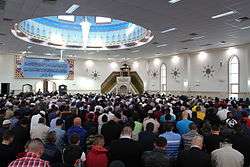Marree Mosque
|
Part of a series on |
| History |
|
Early history |
| Mosques |
|
List of mosques |
| Organisations |
|
Islamic organisations in Australia |
| Groups |
|
Afghan • Albanian • Arab • Bangladeshi |
| Events |
| People |
| Prominent Australian Muslims Ibrahim Abu Mohamed |
The Marree Mosque was built in Marree, South Australia around 1882 (some sources indicate as early as 1861[1]), by members of the South Australian "Afghan" community.[2] These "Afghans" were generally Muslims from then-British India, although some came from Afghanistan, Pakistan and the Middle East. They worked as cameldrivers and breeders in the region.[3] Figures indicate an approximation that 3000 "Ghans" were involved in this type of work until it was overtaken by the car and train in the 1930s.[2][3]
The mosque was constructed by camel breeder Abdul Kadir (Australia), owner of Wangamanna Station.[4] Another camelleer, Mullah Assim Khan, became imam of the Marree mosque in the early 20th century. The town eventually had two mosques, the northern of which was abandoned around 1910.[5] Another report indicates a mosque was deliberately demolished in 1956 by its elderly caretaker, Syed Goolamdeen, who could no longer maintain it, since many descendants of Afghans no longer practised Islam.[6]
As of 2003, the descendants of the Afghans in Marree have rebuilt the mosque.[2]

See also
Further reading
- Australia's First Muslims at ArdernObservations blogspot
References
- ↑ Australia. Parliament. Senate. Parliamentary debates (Hansard).: Senate. Commomwealth Govt. Printer. Retrieved 9 September 2012.
- 1 2 3 Leonore Loeb Adler; Uwe Peter Gielen (2003). Migration: Immigration and Emigration in International Perspective. Greenwood Publishing Group. pp. 278–. ISBN 978-0-275-97666-8. Retrieved 9 September 2012.
- 1 2 Adler, L. L. & Gielen, U. P. Migration: Immigration and Emigration in International Perspective. Greenwood Publishing Group. Retrieved 15 March 2015.
- ↑ Pip Wilson (30 October 2006). Faces in the Street. Lulu.com. pp. 546–. ISBN 978-1-4303-0021-2. Retrieved 9 September 2012.
- ↑ Philip Jones; Anna Kenny (1 February 2010). Australia's Muslim Cameleers: Pioneers of the Inland, 1860s-1930s. Wakefield Press. pp. 124–. ISBN 978-1-86254-872-5. Retrieved 9 September 2012.
- ↑ Migration Museum (22 May 1995). From many places: the history and cultural traditions of South Australian people. Wakefield Press. ISBN 978-1-86254-347-8. Retrieved 9 September 2012.
Coordinates: 29°39′05″S 138°03′47″E / 29.651346°S 138.063082°E
